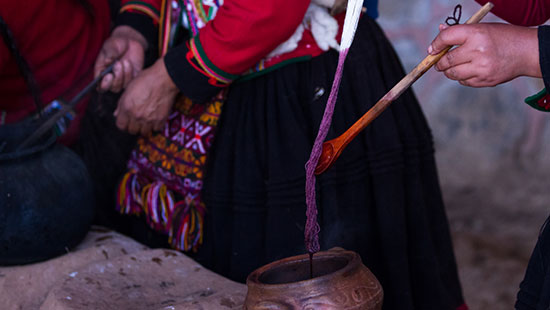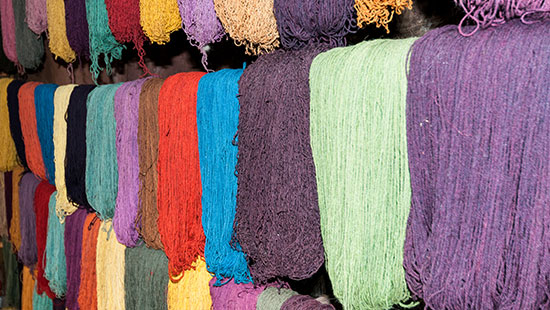
Andean weavers are world renowned for their immense skills and rich traditions that produce vibrant, colorful, complex creations. Weaving in the Andes is as strong today as it ever was and it’s a tradition that goes back at least ten thousand years. With all of that history behind it, how could these textiles be anything short of spectacular?
Weaving the Andean way

Traditional Andean textile production starts with shearing organic fiber from herds of alpaca, llama, vicuña or sheep that families carefully care for and sheer themselves. The fiber is washed using plant-based soap made with local ingredients and hand spun using a drop spindle. The threads are then dyed with natural dyes made from insects, plants and minerals found nearby. The result is a buttery soft fiber in beautiful colors that reflect the natural world around them.
Cloth is woven using traditional back-strap and four post looms. Perhaps one of the most incredible things about Andean weavers is that they do not weave cloth to be cut into pieces and sewn together later. Instead, the pieces are woven to size and shape with finished edges and removed from the loom without cutting threads. Imagine the skill, concentration and planning it takes to do that!
Visit Awana Kancha

When in Cuzco, you’re likely to come across Awana Kancha, a living museum of the Peruvian Andes where you can learn lots about the centuries-old methods of spinning, dying and weaving traditional textiles. If you’re like most people, you’re going to want to bring home a marvelous piece as a souvenir after this experience.
Make Sure You Are Getting the Real Deal

Alpaca wool is very soft and warm, making it perfect for cold weather. Travelers on an Andes tour frequently purchase things like sweaters, scarves, gloves and hats when they visit, but many times things that are sold as alpaca are actually made out of synthetic material made to look and feel like alpaca. The good news is that there are several ways to make sure you are getting the real thing.
- Price is a big indicator of quality. If it’s inexpensive, it’s probably not the real thing. Alpaca products are made to last a lifetime, so they are worth the extra money
- Extremely bright colors might be synthetic. Alpaca wool is dyed with natural products that produce somewhat more muted colors. They can still be quite vibrant, so don't judge based on color alone
- Alpaca wool is much heavier than synthetic
- Alpaca feels cool to the touch
- For the most part, alpaca products don’t have inside seams since they are woven in one piece
You don’t have be a textile enthusiast to appreciate the incredible beauty of Andean textiles. Now that you know the history of this marvelous work and how to tell real from synthetic, we think you should put an alpaca garment on the top of your list of things to buy in Peru.

